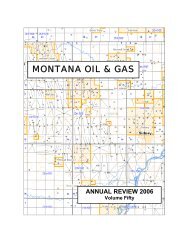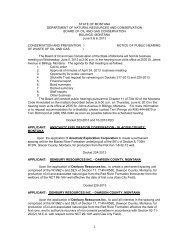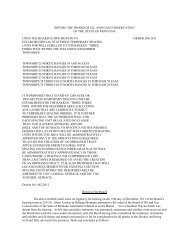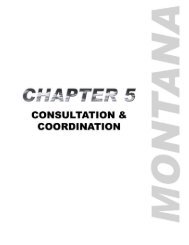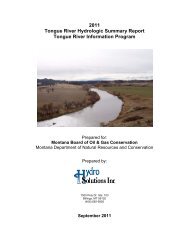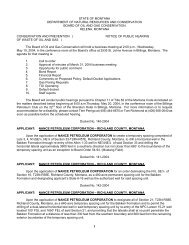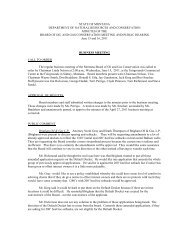Microsoft Office Outlook - Memo Style - Montana Board of Oil and Gas
Microsoft Office Outlook - Memo Style - Montana Board of Oil and Gas
Microsoft Office Outlook - Memo Style - Montana Board of Oil and Gas
You also want an ePaper? Increase the reach of your titles
YUMPU automatically turns print PDFs into web optimized ePapers that Google loves.
(2) Prior to initiation <strong>of</strong> fracture stimulation, production casing or intermediate casing must be<br />
tested to the maximum anticipated treating pressure in the unsupported (uncemented) portion<br />
<strong>of</strong> the casing exposed to treating pressure. If the casing fails the pressure test it must be<br />
repaired or the operator must use a temporary casing string (fracturing string).<br />
(a) A fracturing string must be stung into a liner or run on a packer set not less than 100 feet<br />
below the cement top <strong>of</strong> the production or intermediate casing <strong>and</strong> must be tested to not<br />
less than maximum anticipated treating pressure minus the annulus pressure applied<br />
between the fracturing string <strong>and</strong> the production or immediate casing.<br />
(3) A casing pressure test will be considered successful if the pressure applied has been held for 15<br />
minutes with no more than five percent pressure loss.<br />
(4) A pressure relief valve(s) must be installed on the treating lines between pumps <strong>and</strong> wellhead<br />
to limit the line pressure to the test pressure determined above.<br />
(5) The surface casing valve must remain open while hydraulic fracturing operations are in<br />
progress; the annular space between the fracturing string <strong>and</strong> the intermediate or production<br />
casing must be monitored <strong>and</strong> may be pressurized to a pressure not to exceed the pressure<br />
rating <strong>of</strong> the lowest rated component that would be exposed to pressure should the fracturing<br />
string fail.<br />
NEW RULE V WORK-OVER, RECOMPLETION, WELL STIMULATION NOTICE<br />
(1) No existing well may be re-perforated, re-completed, re-worked, chemically stimulated, or<br />
hydraulically fractured without the Operator providing notice to the <strong>Board</strong> by submitting a<br />
Form No. 2 no less than forty-eight (48) hours prior to performing such well work activities <strong>and</strong><br />
the Operator may perform the proposed well work activities upon the earlier <strong>of</strong> receipt <strong>of</strong><br />
<strong>Board</strong> approval or the expiration <strong>of</strong> the forty-eight (48) hour prior notice period required under<br />
this section. Within 30 days following completion <strong>of</strong> the well work, a subsequent report <strong>of</strong> the<br />
actual work performed must be submitted on Form No. 2.<br />
(2) Well repairs, including tubing, pump, sucker rod replacement or repair, repairs <strong>and</strong><br />
reconfiguration <strong>of</strong> well equipment which do not substantially change the mechanical<br />
configuration <strong>of</strong> the well bore or casing do not require prior approval or a subsequent report.<br />
Acid <strong>and</strong> chemical treatments <strong>of</strong> less than 5000 gallons, hot oil treatments, <strong>and</strong> similar<br />
treatments intended to clean perforations, remove scale or paraffin, or remedy near-well bore<br />
damage do not require prior approval.



